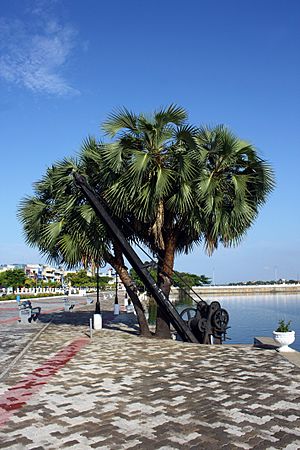Hyphaene thebaica facts for kids
Quick facts for kids Hyphaene thebaica |
|
|---|---|
 |
|
| Doum Palm in Batticaloa, Sri Lanka | |
| Conservation status | |
| Scientific classification | |
| Genus: |
Hyphaene
|
| Species: |
thebaica
|
The doum palm (also called the gingerbread tree) is a special type of palm tree. It grows tasty oval-shaped fruits. This tree naturally grows in the Arabian Peninsula and the northern and western parts of Africa. You'll often find it in places where there's water underground.
Contents
What is a Doum Palm Like?
The doum palm is a tall tree that can grow up to 17 meters (about 56 feet) high. Its trunk can be as wide as 90 centimeters (about 3 feet) around! What's cool about this palm is that its trunk often splits into two branches, and then those branches split again. This gives it a unique look.
At the end of each branch, there are big bunches of leaves. The tree's bark is smooth and dark grey. It has marks from old leaves that have fallen off. The leaf stalks are about a meter (3 feet) long. They have strong, curved claws that point upwards. The leaves themselves are shaped like a fan and can be very large, around 120 by 180 centimeters (about 4 by 6 feet).
Doum palms have separate male and female trees. This means that male flowers grow on one tree, and female flowers grow on another. Both types of flowers grow in long bunches, up to 1.2 meters (4 feet) long. Female trees produce large, woody fruits. Each fruit has one seed inside. These fruits stay on the tree for a long time.
Where Doum Palms Grow and Live
The doum palm is originally from the northern half of Africa. You can find it all across the Sahel region, which is a dry area south of the Sahara Desert. It grows from countries like Mauritania and Senegal in the west, through Central Africa, and all the way to Egypt, Kenya, Somalia, and Tanzania in the east.
These trees usually grow where there's water underground. This is why they are often seen along rivers like the Nile River in Egypt and Sudan, or the Niger River in West Africa. They also grow in dry riverbeds called wadis and at oases (green spots in deserts where water is found). Sometimes, they can even grow away from water on rocky hillsides. Doum palms don't like very wet soil, but they are very good at surviving bushfires.
How People Use the Doum Palm
The doum palm thrives in hot, dry places where not many other plants can grow. People really value this tree, especially for the shade it provides. Almost every part of the doum palm is useful!
The leaves are one of the most important parts. People living along the Niger and Nile Rivers use the fibers and leaflets from the leaves to make many things. They weave baskets, mats, rough fabrics, brooms, ropes, string, and even thatch for roofs.
The wood from the tree is used for posts, poles, furniture, and even beehives. It's also a good source of wood for fuel. The leaf stalks are used for fencing. Other things made from the doum palm include fishing rafts, hammocks, carpets, buttons, and beads.
Doum Palm as Food
The fruits of the doum palm are edible. In Eritrea, they are called Akat or Akaat. The thin, dry, brown skin of the fruit can be used to make molasses, cakes, and sweet treats. Even the unripe seeds inside the fruit can be eaten. The young shoots that sprout from germinating seeds are also eaten as a vegetable.
In Egypt, you can buy doum fruit from street vendors and in herbal shops. Kids especially love to chew on its sweet and sour, hard, fibrous flesh. Sometimes, the fruit's pulp is roasted with sugar to make a cold summer drink, similar to a carob drink. In parts of India, the tree is known as Hoka Tree, and its red, ripe fruit is called Hoka. In northern Nigeria, the Hausa people call it Goruba. In southeastern Niger, the fruit pulp is called bri, and it's used to flavor a traditional millet pancake called massan bri.
There's even a commercial drink in Niger called Torridité Glacée made from this fruit. It tastes a bit like iced coffee or milk chocolate. Besides eating the fruit, people also get juice from young fruits and make palm wine from the tree's sap.
Doum Palms in Ancient Egyptian Tombs
The ancient Egyptians thought the doum palm was a sacred (holy) tree. Its seeds have been found in many tombs of their kings, called pharaohs.
On September 24, 2007, archaeologists found eight baskets full of 3,000-year-old doum fruit in King Tutankhamun's tomb. Each basket was about 50 centimeters (20 inches) tall. The department that looks after ancient objects said this was a big discovery. Traditionally, these fruits were offered during funerals.
Images for kids
See also
 In Spanish: Palmera dum para niños
In Spanish: Palmera dum para niños




